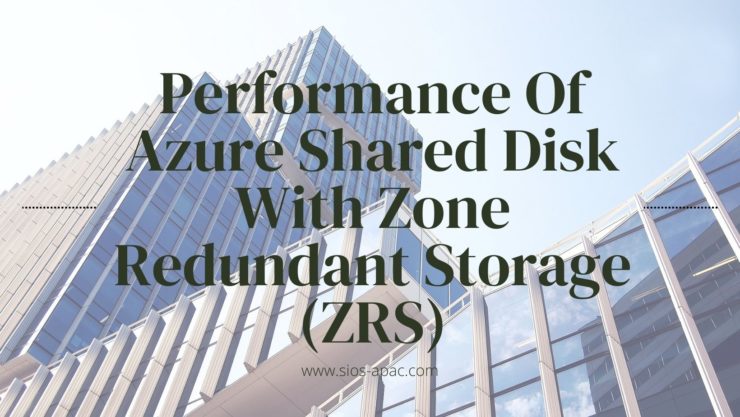Date: May 16, 2022
Tags: Zone Redundant Storage
Performance Of Azure Shared Disk With Zone Redundant Storage (ZRS)
On September 9th, 2021, Microsoft announced the general availability of Zone-Redundant Storage (ZRS) for Azure Disk Storage, including Azure Shared Disk.
What makes this interesting is that you can now build shared storage based failover cluster instances that span Availability Zones (AZ). With cluster nodes residing in different AZs, users can now qualify for the 99.99% availability SLA. Prior to support for Zone Redundant Storage, Azure Shared Disks only supported Locally Redundant Storage (LRS), limiting cluster deployments to a single AZ, leaving users susceptible to outages should an AZ go offline.
There are however a few limitations to be aware of when deploying an Azure Shared Disk with ZRS.
- Only supported with premium solid-state drives (SSD) and standard SSDs. Azure Ultra Disks are not supported.
- Azure Shared Disks with ZRS are currently only available in West US 2, West Europe, North Europe, and France Central regions
- Disk Caching, both read and write, are not supported with Premium SSD Azure Shared Disks
- Disk bursting is not available for premium SSD
- Azure Site Recovery support is not yet available.
- Azure Backup is available through Azure Disk Backup only.
- Only server-side encryption is supported, Azure Disk Encryption is not currently supported.
I also found an interesting note in the documentation.
“Except for more write latency, disks using ZRS are identical to disks using LRS, they have the same scale targets. Benchmark your disks to simulate the workload of your application and compare the latency between LRS and ZRS disks.”
While the documentation indicates that ZRS will incur some additional write latency, it is up to the user to determine just how much additional latency they can expect. A link to a disk benchmark document is provided to help guide you in your performance testing.
Following the guidance in the document, I used DiskSpd to measure the additional write latency you might experience. Of course results will vary with workload, disk type, instance size, etc.,but here are my results.
| Locally Redundant Storage (LRS) | Zone Redundant Storage (ZRS) | |
| Write IOPS | 5099.82 | 4994.63 |
| Average Latency | 7.830 | 7.998 |
The DiskSpd test that I ran used the following parameters.
diskspd -c200G -w100 -b8K -F8 -r -o5 -W30 -d10 -Sh -L testfile.dat
I wrote to a P30 disk with ZRS and a P30 with LRS attached to a Standard DS3 v2 (4 vcpus, 14 GiB memory) instance type. The shared ZRS P30 was also attached to an identical instance in a different AZ and added as shared storage to an empty cluster application.
A 2% overhead seems like a reasonable price to pay to have your data distributed synchronously across two AZs. However, I did wonder what would happen if you moved the clustered application to the remote node, effectively putting your disk in one AZ and your instance in a different AZ.
Here are the results.
| Locally Redundant Storage (LRS) | Zone Redundant Storage (ZRS) | ZRS when writing from the remote AZ | |
| Write IOPS | 5099.82 | 4994.63 | 4079.72 |
| Average Latency | 7.830 | 7.998 | 9.800 |
In that scenario I measured a 25% write latency increase. If you experience a complete failure of an AZ, both the storage and the instance will failover to the secondary AZ and you shouldn’t experience this increase in latency at all. However, other failure scenarios that aren’t AZ wide could very well have your clustered application running in one AZ with your Azure Shared Disk running in a different AZ. In those scenarios you will want to move your clustered workload back to a node that resides in the same AZ as your storage as soon as possible to avoid the additional overhead.
Microsoft documents how to initiate a storage account failover to a different region when using GRS, but there is no way to manually initiate the failover of a storage account to a different AZ when using Zone Redundant Storage. You should monitor your failover cluster instance to ensure you are alerted any time a cluster workload moves to a different server and plan to move it back just as soon as it is safe to do so.
You can find yourself in this situation unexpectedly, but it will also certainly happen during planned maintenance of the clustered application servers when you do a rolling update. Awareness is the key to help you minimize the amount of time your storage is performing in a degraded state.
I hope in the future Microsoft allows users to initiate a manual failover of a ZRS disk the same as they do with GRS. The reason they added the feature to GRS was to put the power in the hands of the users in case automatic failover did not happen as expected. In the case of Zone Redundant Storage, I could see people wanting to try to tie together storage and application, ensuring they are always running in the same AZ, similar to how host based replication solutions like SIOS DataKeeper do it.
